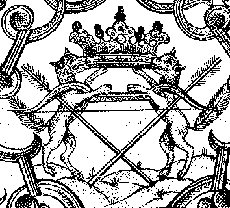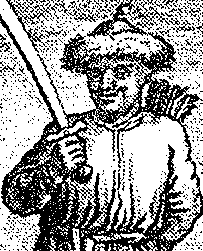Beginning of the part
The first half of the XVIIth century
The first half of the XVIIIth century
The second half of the XVIIIth century
The first half of the XIXth century
The second half of the XIXth century
Beginning of the XXth century

Siberian Emblem.
From the Tsar Deed 1690

Kalmick.
Engraving from the book, the end of the XVIIth century
|
To the beginningof the 1650-s the basis of Tircik-speaking population in the Uper
Ob was Teleuts. Their clan union was divided in 2 branches: Ulus Abakovich, which was
leaded by Koka, and Ulus Machik, Abak's nephew.
Teleuts were dominated by the Dgungarian empire of West Siberian Mongolian-Oirats,
with Batoor-hontaidgi at their head.In the russian data of that time Koka and Machik
are called "his servants". From the same data it is known that in autumn 1652 Koka
went to Urga - the nomadic site of dgungarian governor, and he always came back
accompained by two dgungarian commanders and by a 3 thousand troops.
After Batoor died the political situation became sharp. The intestine
struggle for the throne led to the weakening of the state. In this situation
the war conflicts began in the Upper Ob, which got the historic name "teleut-oirat wars".
But the try of Koka and Machik to get free from the dgungarian citizenship finally
didn't succeed. Sengi-hontaidgi, who seized in Dgungaria, managed to suppress unruly
Teleut princes. As the historian I. Fisher shows, Koka died as a "fugitive in the steppe"
in 1669 or 1670.
The siberian authorities were informed about the events that happened in Dgungaria
after Bator's death, they knew about the civil wars between the Teleuts and Oirats.
One of the russian ambassadors was the witness of the battle in June 1658, in which
Koka' and Machik's troopswere destroyed by the coalition of Mongolians and Teleuts, with the
junior son of Abak - Torgout - at their head. In this situation the russian authorities
held the neutrality and didn't interfere in the struggle. In the 1660-s Tomsk voivodes,
recognising Koka and Machik to be the tribute-payers of Dgungaria, asked Senge for help
to calm down Teleuts, who made many raids on the Tomsk and Kuznetsk districts.
From 1670 to 1697 the governor og Dgungaria was Galdan Boshoktow-Khan. The
interrelations of Teleuts and the West Mongolian state in this period varied, dependintg
on strengthning or weakening of the central power. In the time of feudal disputes
and hittings of Galdan, who waged the war with China and eastern Mongolians,
the independence of Teleut princes increased. In the period, when Galdan strehgthened
his power on Teleuts, his influence acquired a striking character.
From the end of the 1670-s Abak's grandson - Tabun Kokin - was deprived of the right
to solve the problem of war and peace, although right to the 1690-s he continued
to be independent from Boshoktow-Khan. Tabun's sons, who reigned from the end of the
XVIIth century, changed from the half-dependent owners into officials of dgungarian
Khan.
The siberian authorities in the second half of the XVIIth century didn't undertake
active operations in annexations ofthe Upper Ob-side to Russia.The southern border
of Russiain the Ob-side streched along the Inja (near Novosibirsk). At the end of the
XVIIth century the boundary with the "Teleut land" was marked on russian draughts
some lower, along the river Berd. That meant the place between the Inja and the Berd
was included into the territory of the Tomsk province. The tries to build the fortress
on the mouth of the Bija and the Katun were renewed at the beginning of the XVIIIth century.
|